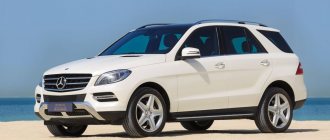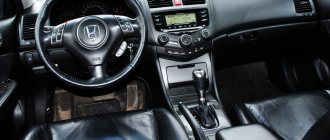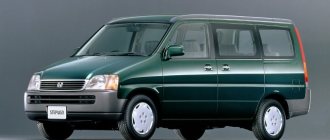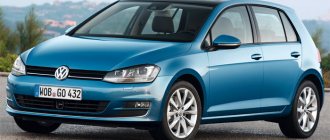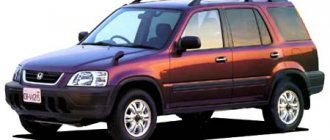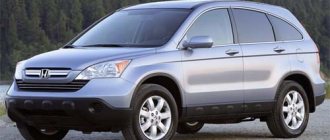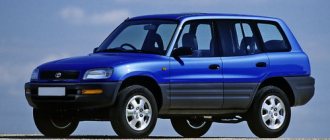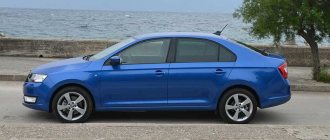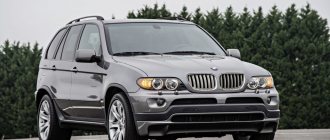Second generation
Acura Integra GS, second generation (USA)
The second generation Honda Integra was released in 1989 and was produced until 1993. It was on the car of this generation that the famous B16A engine with the VTEC system was first installed - the world's first serial atmospheric car engine with a specific power of 100 hp. per liter of working volume. This generation Honda Integra was produced in two body styles: a three-door coupe and a four-door sedan.
Four types of engines were installed on cars:
— ZC with dual horizontal Keihin carburetors 1.6 l/105 hp.
— ZC with PGM-FI injection 1.6 l/120 hp.
— B16A first generation with VTEC system 1.6 l / 160 hp. (with manual transmission)/150 hp. (with automatic transmission)
In 1991-1993, the following was added to the range of engines:
— B16A second generation with VTEC system 1.6 l / 170 hp. (with manual transmission)/155 hp. (with automatic transmission)
All modifications of the Integra DA series bodies have an independent suspension with double wishbones and a stabilizer at both the front and rear. The front brakes on all modifications are ventilated discs. The rear ones on the RX, ZX, ZX-EXTRA, TXi modifications are drum, and on the RXi, ZXi, RSi, XSi they are disc.
All modifications can be equipped with either a five-speed manual transmission or a four-speed six-position automatic with electronic control (on cars with a ZC engine, single-mode, and on cars with a B16A engine, with two modes: Sport and Normal).
Some examples of this generation are interesting because they combine the simplest engine and high-tech interior equipment. The list of equipment may include: steering wheel height adjustment, electrically adjustable mirrors painted in the color of the car, an automatic transmission selector position indicator on the instrument panel, a reminder signal for the lights not turned off, a digital quartz clock, two glove compartments, trunk opening levers and gas tank caps from the passenger compartment, pocket behind the passenger seat, rear window with electric heating, front seats with developed lateral support, bumpers in body color, power steering, electric windows, push-button control of the climate control unit, air conditioning, climate control, front seat headrests with a cutout for better visibility, double rear seat with deep niches and an armrest, a tachometer, a wing on the trunk, etc.
Review of Honda Integra 2nd generation 1989, 1990, 19991, 1992
The second generation Honda Integra was released in April 1989. Compared to the first body, the prefix “Quint (first generation Integra)” was removed from the model name, and now it’s simply: Honda Integra. In North America, the car was sold under the Acura brand. The car was produced in two body styles: sedan and coupe.
Honda Integra coupe
In November 1986, Honda engineers were tasked with developing a new “heart” for the 1989 Honda Integra. The goal was achieved and the B16A engine with the proprietary VTEC system was presented to the public; this is the first atmospheric unit in world practice from which one hundred horses were “removed” from one liter of displacement!
With a volume of 1.6 liters, it produced 160 horsepower at 7600 rpm, with a redline of 8000 rpm! And this engine was installed on the second generation Honda Integra.
Later, the engine was installed on the Honda Civic, and 13 years later the Japanese released the Honda s2000, which had a 2-liter naturally aspirated F20C engine with 240 hp, this record is listed in the Guinness Book! Probably everyone has heard about Honda's VTEC system. This is the legendary valve timing system, which allows you to save fuel at low speeds, and at high speeds press the driver into the seat :))), since maximum power is produced when the engine “spins up”.
VTEC engine structure
When developing the Integra, preference was given to comfort, efficiency and sporty character. It’s not in vain that engineers worked to develop a 160-horsepower unit. With this engine and a 5-speed manual transmission, the Honda Integra accelerated from zero to one hundred in 7.7 seconds. But the range of engines does not end there; there were others:
- B18B 1.8 140 hp
- B17A 1.7 160 hp (North American specification)
In 1992, the B16A was boosted and it produced 170 hp.
ZC series on Honda Integra:
- ZC carburetor 1.6/105 hp
- ZC with injection 1.6l/120 hp
Engineers not only worked on the engines, but Honda Integra owners still praise the chassis. Controllability and smoothness are at the highest level. The car has a light, rigid body, and all modifications have an independent suspension with double wishbones and a stabilizer at the rear and front. This chassis, coupled with a lightweight body, guarantees excellent handling.
For braking of the Honda Integra, on all modifications there are ventilated disc brakes at the front, and at the rear on the rxi, rsi, xsi trim levels, and on the rest - drum brakes.
There are two transmissions to choose from, a 5-speed manual and a 4-speed automatic. The B series engines were equipped with a four-speed six-position automatic transmission with electronic control and a choice of 2 driving modes: Sport and normal. On Honda Integra, which came with ZC series engines, an “automatic” was installed without a choice of driving modes.
Honda integra sedan
When I write about cars of the 80s or 90s, I often use the phrase: “The model had very rich and high-tech equipment for those times.” So, the 1989 Honda Integra still has high-tech and rich equipment even today! This can be confirmed by the Emperor of Japan Akihito, because he has personally driven a 1991 Honda Integra for more than 20 years! Akihito likes to ride it with his wife to the tennis court, he drives in compliance with traffic rules.
The Emperor gets into his Honda
It is comfortable for both the driver and passengers to sit in the car, ergonomics are at the highest level. As mentioned above, the car is well equipped, regardless of the engine, the models were equipped with: Electrically heated windows, adjustable steering wheel, gear selector indicator, reminder of the lights not turned off, automatic windows, power steering, climate control, quartz clock, seats with developed lateral support and much more.
Interior of Honda Integra 1989-1993
The car was produced until 1993. In the same 93, a new Honda Integra body came to replace it.
Technical characteristics of Honda Integra 1989-1993
Technical characteristics of Honda Integra sedan, engine ZC 1.6 105 hp, 120 hp (dimensions in mm)
• Production date: 1989-1993 • Body: sedan • Number of doors: 5 • Number of seats: 5 • Length: 4480 • Width: 1695 • Height: 1420 • Wheelbase: 2600 • Ground clearance: 150 • Tire size: 185/70R13 • Front brakes: disc • Rear brakes: Depending on the configuration • Engine: 105 hp 135 Nm (carburetor) 120 hp 144 Nm (distributive injection) • Drive: front. • Transmission: 5-speed manual, 4-speed automatic. • Fuel consumption:9.4/100 km/h • Weight: 1010-1190 • Fuel tank volume: 50l • Country of origin: Japan
Technical characteristics of the coupe with the B16a engine (dimensions in mm)
• Production date: 1989-1993 • Body: coupe • Number of doors: 5 • Number of seats: 5 • Length: 4390 • Width: 1695 • Height: 1325 • Wheelbase: 2550 • Ground clearance: 150 • Tire size: 195/60R14 • Front brakes: disc • Rear brakes: Depending on the configuration • Engine: 160 hp 152 Nm (B16a) • Drive: front. • Transmission: 5-speed manual, 4-speed automatic. • Acceleration 0-100: 5 mt-7.7 sec. • Fuel consumption:9.4/100 km/h • Weight: 990-1170 • Fuel tank volume: 50l • Country of origin: Japan
Second generation price
It will be difficult to find one in the same condition as the Emperor of Japan. You will have to spend a long time searching, or take on the task of restoring a “tired” copy yourself. Prices start from 50 thousand rubles to 190 thousand rubles.
Maintenance Intervals and Tips
Regulations and recommendations for servicing Honda Integra, taken from the website Hondavodam.ru
Tuning
Hondas with B-series engines are loved by tuners, as the potential of the engines is enormous. At one time, the B16a was already the most powerful naturally aspirated aircraft in the world, its power can be increased higher.
If the engine is given more displacement, about 40 horsepower will be added, this is done by replacing the block from the B20B. They also perform a swap on the B18c or K20A, or install a turbine on the engines, the power is impressive.
Interesting Facts
• This is the “first-born” from Honda with a B16A engine and a proprietary VTEC system. • B16a is the record holder among atmospheric engines in terms of specific power per 1 liter of working volume. • The Emperor of Japan, Akihito, drives the 2nd generation Honda Integra; he has owned it since 1991.
Model history
• In February 1980, Honda launched a model called Quintet, this car fills the lineup between the Civic and Accord. This model marked the beginning of the Honda Integra.
• In 1985, the Honda Quint Integra model was released; this model can rightfully be considered the first Honda Integra.
Video
Advertising Honda integra 1989-1993
Third generation
It was produced from 1991 to 2001 in two bodies: a four-door sedan (DB6, DB7, DB8, DB9) and a two-door hatchback (DC1, DC2, DC4). There were also two types of front of the car: big-eyed (4 round small headlights, typical for the European and American markets) and with long headlights similar to the DA generation. DB6, DC1 - integras were equipped with a 1.6l ZC engine, also known as non-vtec D16 (in different variations: carburetor/injection 105/120 hp, single-shaft SOHC engines), manual transmission s8g, automatic transmission, right-hand drive. DB7,DC4 - equipped with a B18V 140-horsepower engine (non-vtec), left-hand drive, usually with a big-eyed muzzle, were exported. DC4 had a TypeR version with a B18C engine (190 hp). Each car is numbered and has its own nameplate with the production number, under the handbrake lever. A total of 10,000 vehicles were produced.
DB8, DC2 - right-hand drive lighters, equipped with a V18c engine, in two variations SiR - 170/180 horsepower blackhead V18c (automatic/manual transmission), automatic or manual transmission, and TypeR - 200 horsepower redhead V18c, manual transmission with LSD. The 1.8-liter engine used variable valve opening timing and fuel injection timing with variable advance, low-friction pistons, and a more powerful free exhaust system [source not specified 1395 days]. DC2 spec 96 - s80 gearbox with LSD, GP - 4.40, disc brakes 262 front 242 rear, wheel drilling 4*114.3, anti-roll bars front/rear 24/22 mm, R15 wheels. DC2 spec 98 - s80 gearbox with LSD, GP - 4.78, disc brakes 282 front 262 rear, wheel drilling 5*114.3, anti-roll bars 25/23 mm, R16 wheels. The anniversary spec 00 also has a difference from the previous version - different engine and suspension settings, the spec 00 also has a yellow body color, with yellow recaro front seats, a black interior with Alcantara and yellow stitching. DB9 is an all-wheel drive version, with a ZC engine and right-hand drive.
Fourth generation
This car was produced only in a two-door version in the DC5 body with a new generation K20A engine producing 220 hp (Type R) and 160 hp (Type S, IS). Acceleration time for a 220 horsepower engine from 0-100 km.h. 6.2 s. Fuel consumption in the Type S version is 11 l/100 km. The type-r package includes: 4-piston Brembo brakes (300mm discs), Recaro front seats, differential lock (LSD), Enkei forged wheels, 4 braces to increase body rigidity, steering wheel, pedals and Momo gear knob. Production ceased in 2006.
Specifications
| Honda Integra Coupe (DC2) 1.6 ZXi (120 Hp) | |
| Body type | Coupe |
| Number of doors | 2 |
| Number of seats | 4 |
| Length | 4380 mm |
| Width | 1695 |
| Height | 1335 mm |
| Wheelbase | 2570 mm |
| Front track | 1475 mm |
| Rear track | 1465 mm |
| Ground clearance | 0 mm |
| Engine location | Front, transverse |
| Maximum trunk volume | 1590 cm3 |
| Power | 120 hp |
| At rpm | 6300 |
| Torque | 142/5500 n*m |
| Supply system | Distributed injection |
| Availability of turbocharging | — |
| Gas distribution mechanism | ohc |
| Cylinder arrangement | Row |
| Number of cylinders | 4 |
| Cylinder diameter | 75 mm |
| Piston stroke | 90mm |
| Compression ratio | 9.1 |
| Number of valves per cylinder | 4 |
| Fuel | AI-98 |
| Drive unit | Front |
| Number of gears (mech) | 5 |
| Number of gears (auto) | 4 |
| Front suspension type | Helical spring |
| Rear suspension type | Helical spring |
| Front brakes | Ventilated disc |
| Rear brakes | Drums |
| ABS | There is |
| Power steering | Power steering |
| Steering type | Rack and pinion |
| Maximum speed | 175 km/h |
| Fuel consumption Combined cycle | 5.5 l/100km |
| Fuel tank volume | 50 l |
| Vehicle curb weight | 1050 kg |
| Tire size | 185/65 R14 |
| Honda Integra Coupe (DC2) 1.8 i (142 Hp) | |
| Body type | Coupe |
| Number of doors | 2 |
| Number of seats | 4 |
| Length | 4380 mm |
| Width | 1710 |
| Height | 1290 mm |
| Wheelbase | 2570 mm |
| Front track | 1475 mm |
| Rear track | 1470 mm |
| Ground clearance | 0 mm |
| Trunk volume is minimal | 224 l |
| Engine location | Front, transverse |
| Maximum trunk volume | 1834 cm3 |
| Power | 142 hp |
| At rpm | 6300 |
| Torque | 172/5200 n*m |
| Supply system | Distributed injection |
| Availability of turbocharging | — |
| Gas distribution mechanism | dohc |
| Cylinder arrangement | Row |
| Number of cylinders | 4 |
| Cylinder diameter | 81 mm |
| Piston stroke | 89mm |
| Compression ratio | 9.2 |
| Number of valves per cylinder | 4 |
| Fuel | AI-98 |
| Drive unit | Front |
| Number of gears (mech) | 5 |
| Number of gears (auto) | 4 |
| Front suspension type | Helical spring |
| Rear suspension type | Helical spring |
| Front brakes | Ventilated disc |
| Rear brakes | Disk |
| ABS | There is |
| Power steering | Power steering |
| Steering type | Rack and pinion |
| Fuel consumption Combined cycle | 8.6 l/100km |
| Fuel tank volume | 50 l |
| Vehicle curb weight | 1170 kg |
| Tire size | 195/60 R14 |
| Honda Integra Coupe (DC2) 1.8 i (180 Hp) | |
| Body type | Coupe |
| Number of doors | 2 |
| Number of seats | 4 |
| Length | 4380 mm |
| Width | 1695 |
| Height | 1335 mm |
| Wheelbase | 2570 mm |
| Front track | 1475 mm |
| Rear track | 1465 mm |
| Ground clearance | 0 mm |
| Engine location | Front, transverse |
| Maximum trunk volume | 1797 cm3 |
| Power | 180 hp |
| At rpm | 7600 |
| Torque | 175/6200 n*m |
| Supply system | Distributed injection |
| Availability of turbocharging | — |
| Gas distribution mechanism | dohc |
| Cylinder arrangement | Row |
| Number of cylinders | 4 |
| Cylinder diameter | 81 mm |
| Piston stroke | 87.2mm |
| Compression ratio | 10.6 |
| Number of valves per cylinder | 4 |
| Fuel | AI-95 |
| Drive unit | Front |
| Number of gears (mech) | 5 |
| Number of gears (auto) | — |
| Front suspension type | Helical spring |
| Rear suspension type | Helical spring |
| Front brakes | Ventilated disc |
| Rear brakes | Disk |
| ABS | There is |
| Power steering | Power steering |
| Steering type | Rack and pinion |
| Maximum speed | 210 km/h |
| Fuel consumption Combined cycle | 6.1 l/100km |
| Fuel tank volume | 50 l |
| Vehicle curb weight | 1100 kg |
| Tire size | 195/55 R15 |
| Honda Integra Coupe (DC5) 2.0 16V Type R (220 Hp) | |
| Body type | Coupe |
| Number of doors | 2 |
| Number of seats | 4 |
| Length | 4385 mm |
| Width | 1695 |
| Height | 1380 mm |
| Wheelbase | 2570 mm |
| Front track | 1490 mm |
| Rear track | 1490 mm |
| Ground clearance | 150 mm |
| Trunk volume is minimal | 504 l |
| Engine location | Front, transverse |
| Maximum trunk volume | 1998 cm3 |
| Power | 220 hp |
| At rpm | 8000 |
| Torque | 206/7000 n*m |
| Supply system | Distributed injection |
| Availability of turbocharging | — |
| Gas distribution mechanism | dohc |
| Cylinder arrangement | Row |
| Number of cylinders | 4 |
| Cylinder diameter | 86 mm |
| Piston stroke | 86mm |
| Compression ratio | 11.5 |
| Number of valves per cylinder | 4 |
| Fuel | AI-98 |
| Drive unit | Front |
| Number of gears (mech) | 6 |
| Number of gears (auto) | — |
| Gear ratio of the main pair | 4.76 |
| Front suspension type | Helical spring |
| Rear suspension type | Helical spring |
| Front brakes | Ventilated disc |
| Rear brakes | Disk |
| ABS | There is |
| Power steering | Power steering |
| Steering type | Rack and pinion |
| Maximum speed | 240 km/h |
| Fuel tank volume | 50 l |
| Vehicle curb weight | 1170 kg |
| Permissible gross weight | 1400 kg |
| Tire size | 215/45 ZR17 |
| Honda Integra Coupe (DC5) 2.0 i 16V (160 Hp) | |
| Body type | Coupe |
| Number of doors | 2 |
| Number of seats | 4 |
| Length | 4385 mm |
| Width | 1695 |
| Height | 1380 mm |
| Wheelbase | 2570 mm |
| Front track | 1485 mm |
| Rear track | 1485 mm |
| Ground clearance | 150 mm |
| Trunk volume is minimal | 504 l |
| Engine location | Front, transverse |
| Maximum trunk volume | 1998 cm3 |
| Power | 160 hp |
| At rpm | 6500 |
| Torque | 191/4000 n*m |
| Supply system | Distributed injection |
| Availability of turbocharging | — |
| Gas distribution mechanism | dohc |
| Cylinder arrangement | Row |
| Number of cylinders | 4 |
| Cylinder diameter | 88 mm |
| Piston stroke | 86mm |
| Compression ratio | 9.8 |
| Number of valves per cylinder | 4 |
| Fuel | AI-95 |
| Drive unit | Front |
| Number of gears (auto) | 5 |
| Gear ratio of the main pair | 4.39 |
| Front suspension type | Helical spring |
| Rear suspension type | Helical spring |
| Front brakes | Ventilated disc |
| Rear brakes | Disk |
| ABS | There is |
| Power steering | Power steering |
| Steering type | Rack and pinion |
| Maximum speed | 200 km/h |
| Fuel tank volume | 50 l |
| Vehicle curb weight | 0 kg |
| Tire size | 195/65 R15 |
A little more information about the Integra 750
The scooter has a DCT box. I talked more about her in my video. However, it should be noted that this is a great solution and will be ideal in this hybrid bike. In addition, because the chain transfers torque to the wheel, the gearbox operation is not as noticeable as it was in the VFR1200X with a driveshaft. D-mode jerk is also standard on every DCT bike I've ridden, so it shouldn't be a concern for new owners.
Honda Integra 750
In theory, scooters have a large luggage compartment and multiple storage spaces. Unfortunately, the Integra doesn't fit into this trend and only offers one small storage unit, which didn't boost my confidence to hide anything, and an under-sofa space that only fits one helmet. It's a little sad here too. There is a cigarette lighter socket, so in theory we could charge something along the way. Unfortunately, the steering wheel is heavily built-in, so installing any handles for the phone or navigation will be difficult.
Honda Integra 750
Overall the Integra looks really great. It has big wheels, an interesting line and a cool sound. Its sound does not resemble a lawn mower and sounds decent. But that big lampshade with the LED headlights and turn signals... It's a shame Honda didn't put indicators on the mirrors - that would have looked cool.
Honda Integra 750
The warning symbols on the clock are clearly visible, but there is no engine temperature indication. Everything else is visible. There are colorful, programmable reverse stripes and other bayeres, but the whole ones are sometimes barely noticeable, especially on days when the sun shines stronger.
Honda Integra 750
It’s also interesting that after washing the Integra we get water in front of our eyes because it’s on turns, but when driving in the rain there are no problems.
There is also a central leg and this is a really good patent. This could not be missed, especially in such equipment, which by default is considered a convenient means of daily movement. And the task is really good. I wholeheartedly recommend the Integra to anyone who values convenience and has been looking for such a combination of motorcycles and scooters.
Below are a few numbers, more detailed information can be found on the manufacturer's website.
| engine's type | Liquid cooled, 4-stroke, 8-valve, SOHC, inline, 2-cylinder with 270° crank |
| capacity | 745 cm3 |
| Maximum power | 54.8 hp at 6250 rpm |
| Maximum torque | 68 Nm at 4750 rpm |
| total length | 2 215 mm |
| Overall Width | 810 mm |
| Overall height | 1440 mm |
| Saddle height | 790 mm |
| Operating weight | 238 kg |
| Fuel tank capacity | 14.1 liters |
Post Views: 12,892
